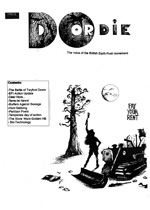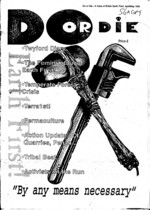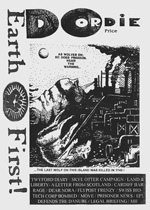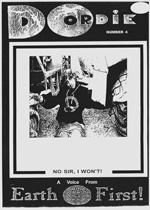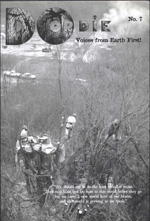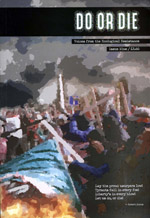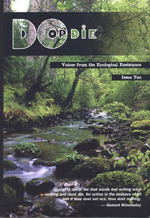The Archives
-
Do or Die, Most Popular, Periodicals
Do or Die – The Complete Set!
04.09.14 | PermalinkDo Or Die #1-10 (1993-2003, Brighton, England.)
A few years ago a friend asked me if I had a complete set of Do or Die, the British Earth First! publication that inspired and incited eco-warriors throughout the 1990s and early 2000s. At one time I did have them, but they had long since been stolen by a Joint Terrorism Task Force.
After a brief discussion, we decided that Do or Die was too important to fade into obscurity. We began tracking down each issue, and decided that while we were at it we ought to archive some other publications as well. That effort is how this web site began, and now, thanks to 56a infoshop of South London and Tim @ NEDS Northampton, we can finally share the very rare issue #2. This completes our collection, and our original mission as well.
When read as a set, Do or Die is a chronicle of people from across the globe counter-striking capitalism, ecocide, and the state. Each issue is better than the last, but more importantly, each page is a spark licking at the fuse of the bomb that is your heart. Once lit, you’ll know that these pages are not mere history, but a reminder that we can explode onto the world stage like the fighters before us have. Do or die, now is the time to rise.
…
-
No Compromise, Periodicals
No Compromise #12-14
05.15.12 | PermalinkNo Compromise #12-14 (1999, Old Bridge, NJ and Santa Cruz, CA)
If I had to create a list of my favorite years in animal and earth liberation history, 1999 would be in the top 5. As the movement looked towards the new millennium there seemed to be an intense urgency in the air, perhaps people felt the need to close the 20th century with a bang or leave their mark before the world ended in a technological melt down on Y2K! Whatever the reasons, direct action reached a fever pitch. Lab raids returned to the United States, the Earth Liberation Front continued it’s ascendancy, Hillgrove farm was shut forever, and everyone seemed to be preparing for the World Trade Organization ministerial in Seattle. Across the globe there was a sense that people were not going to take it anymore, and whether you were struggling against bio-technology or prisons or speciesism, chances are good that you were employing some form of illegal tactic.
No Compromise may not have covered everything going on in the global struggle, but if it was animal lib related then chances are it was covered in these three issues. From the death of Alex Slack to end of the annual Hegins pigeon massacre, you’d be hard pressed to find a more complete overview of these twelve action packed months.
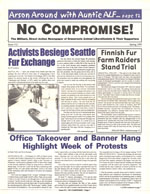
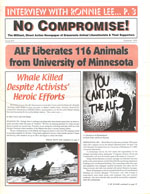
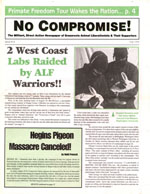
-
No Compromise, Periodicals
No Compromise #9, 10, 11
11.15.11 | PermalinkNo Compromise #9, 10, 11 (1998, Caldwell, NJ.)
After the shakeup caused by Freeman Wicklund’s departure, one might have expected No Compromise to slow it’s publishing schedule while it re-grouped. Instead, they had one of their most productive years, reporting on everything from the first daylight raid in the US, to the murder of Earth First! activist David “Gypsy” Chain. The volume of important articles in these issues is too great to summarize in a tiny blog post, so instead we would just like to encourage you to read each edition thoroughly. Truly, this is one of our favorite posts on Conflict Gypsy so far as it highlights so many significant events in the movement at the end of the 1990s.
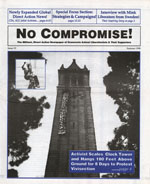
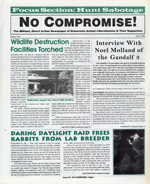

…
-
Do or Die, Periodicals
Do Or Die #6
09.19.11 | PermalinkDo Or Die #6 (1997, Brighton, England.)
“There have been many rational arguments about the usefulness of this action to the campaign, but to anyone who watched the route being transformed from beautiful countryside to churned mud and charred stumps, there is at least a sense of natural justice to the sight of the last tree on route silhouetted by the flames of burning machinery.” -Anon. From the article “Newbury, an adrenaline junkies idea of heaven.”
By the time 1997 rolled around Britons could not help but be aware that something major was afoot in their country. Dock workers were uniting with anti-car anarchists, squatters were preventing the demolition of entire communities by occupying building slated to be torn down, there seemed to be a punk or a hippie in every tree in the whole damned country, and when police got in the way they faced riots as a result. Amidst this flurry of activity though, those on the inside knew that their movement was in terrible danger from forces both internal and external. With time short and resources low they began to discuss how to prevent catastrophe. In the end they failed, but they left behind a wonderful warning of what happens when we analyze our tactics, morale, and outreach too late.
This is not to say that Do Or Die #6 is a doom and gloom journal of a dying movement. Much to the contrary, this issue foresaw the collapse but was written when activity was still peaking. Amongst the analysis of their campaigns and politics, Earth First in the UK and Europe as a whole found plenty of time to get down to the joyous work of resisting industry and capital. There is no way that one can not read some of the stories inside without feeling a boost of adrenaline. From the theft of bulldozers to destroy a construction site to the rampaging of drunken elephants against military bases, to the building of a free state on american soil, all variety of species get down to the usual business of ruining business as usual. Inspiration abounds!

…
-
Periodicals, Underground
Underground #16
06.22.11 | PermalinkUnderground 16 (2001, Ontario, Canada)
Although the cover claims that this issue was released in Spring of 2000, in actuality, the final issue of Underground was so delayed that subscribers received it in the fall of 2001. By this time, the Stop Huntingdon Animal Cruelty campaign was in full swing, the world was seeing regular, large scale riots and street protests at political and industry events, and the Earth Liberation Front was moving the forefront of direct action in the United States. Underground had a number of redeeming features, not the least of which was its comprehensive, worldwide diary of actions, but its publication schedule, the release of Bite Back and the new SHAC newsletter, and the popularity of the internet as a source for news was chipping away at its relevance. It used its final issue to re-publish the Nighttime Gardener, cover the harassment of the ELF press office, and discuss news that was in many cases no longer new.
The magazine had quite a journey from its earlier incarnation as Combat and is clearly one of the most essential documents of the upswing in activity our movement witnessed in the 1990s. Bite Back magazine continues to fill the hole left by Underground’s disappearance, but us old timers will always remember these newsprint treasures with the kind of fondness that only comes from “being there.” It may sound funny, but I sometimes think of these old zines as fallen comrades. In that spirit, let me just say that death has a funny way of being impermanent in the world of activism. Here is to a new generation born from the ashes of those who Underground represented and reported on. Underground is dead, but the Underground lives on.
Also see Underground 1-3 and Underground 4-6 and Underground 7-9 and Underground 10-13 and Underground 14-15.
…
